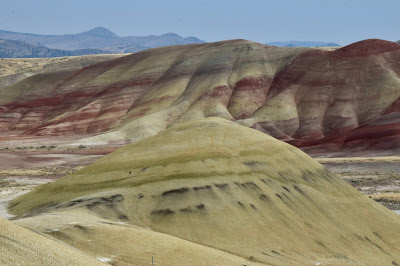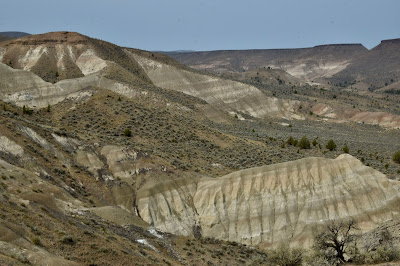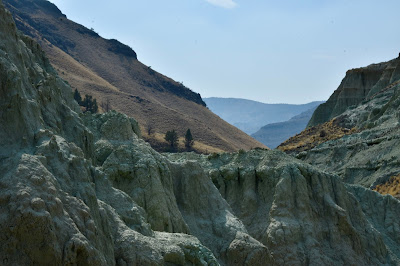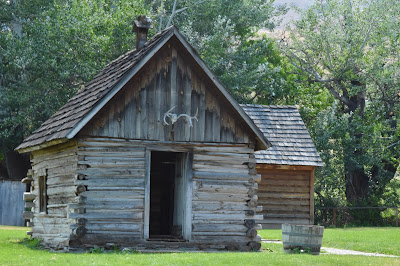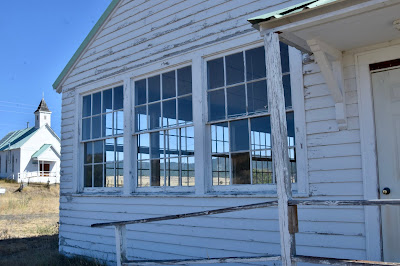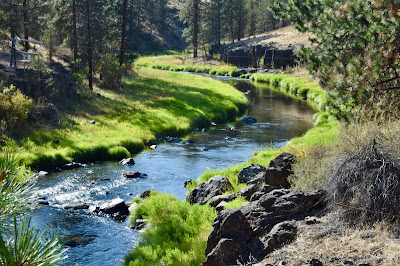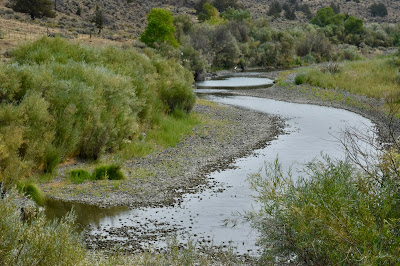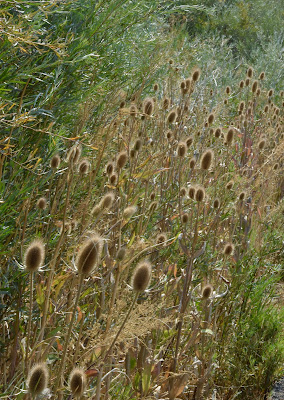A return to eastern Oregon, John Day, fossil beds
A multitude of geological features and two towns are named after John Day, although he had little to nothing to do with any of them. The man is best known for having been robbed of everything, including his clothing, by Indians in the very early 1800s, when he was trapping for the Pacific Fur Company. Not the most prestigious accomplishment, but his name lives on.
Our camp site was in the town of John Day at the county fairgrounds. Years ago, we camped at a fairgrounds (maybe in Nebraska?) but that was a stark blacktop affair; the John Day experience was a quiet tree-shaded spot right on the John Day (of course!) River with a wonderful riverside path which we enjoyed.
We added to our life list there with mountain quail: they were everywhere in great abundance, as were wild turkeys. The trip list grew with Nashville warbler, Wilson's warbler and western wood peewee.
We liked the little town and the river, which we followed through many of its various moods out in the countryside.
The señor was especially excited to see the nearby John Day (of course!) Fossil Beds National Monument. We sauntered aplenty through the multi-hued striped hills and badlandy type terrains. Some of it may have been better characterized as trudging, trekking or hiking, but I'll stick with John Muir's "saunter" description.
As we were retracing our steps on one fairly steep trail, we met a couple who were hosting their grandchildren on vacation. Grandpa was especially anxious to see the end of it when he inquired of us if he was near the trail's terminus. As he leaned on a railing panting, he said he only wanted to be able to say he had done the whole thing. We reassured him that his trek was nearly done as the two grandchildren romped around as if it were nothing.
Not a very birdy environment in those rocky crags, but appropriately enough, we identified a canyon wren lurking within and around a small alcove.
All in all, I was a bit disappointed with the fossil bed experience, a certain case of expectations getting in the way of reality. I had anticipated perhaps seeing a dig in progress or some such. As I learned, they don't even hunt or dig for fossils there any more, but rather wait for Mother Nature to erode them out.
In the past, of course, there were extensive excavations which resulted in a huge body of knowledge about the now-extinct mamallian, avian and plant life forms that once inhabited that region. The Thomas Condon Paleontology and Visitor Center with a working lab was extensive and interesting - quite an educational experience about the climatic evolution there, how it affected plants and mammals that lived there, and the effects of enormous volcanic explosions.
Still, I was a bit miffed at not being able to see in-situ fossils as we have in other places. At least this visitor center was open. So many things have been closed during this journey. Smoke, drought, fire, covid and staffing shortages have had tremendous effects on what we do or how we see things. I can't count the number of times we have opined that something would surely be a fabulous view if only it weren't for the smoke.
Life-giving river, early settlers . . .
The John Day River winds through the fossil beds and across the high plains. In the midst of the National Monument, we were surprised to find the oasis of the historic John Cant Ranch with its grand 1917 main house (closed!), orchard, barns and outbuildings.
Cant was a 1905 Scottish immigrant; he and wife Elizabeth, with four children, provided supplies from their orchards, gardens and livestock for the region's other settlers and miners, and hosted many travelers and locals for social affairs. Across the river from the main house is a cabin that was used to prove up a homestead for one of the Cant's two daughters.
While we were back and forth across the countryside to various sites, we enjoyed seeing so many tiny towns and historic structures. Some ranchers weatherproof their vintage barns; others move away from the land or prefer to build anew.
Some old settlements have been forsaken in favor of town life, or their reason for existence is no longer. At any rate, there are many in varying stages of decay, and a few still in use.
One building, in particular, was eye-catching with what appeared to be an older log structure expanded to be a larger barn.
Move Oregon's border . . .
There is no doubt that the folks in that region are true-blue Americans who are extremely outspoken in their conservative views. We saw many postings on residences and businesses promoting their views on national and local affairs.
One that I have read about before involves advocating for eastern Oregon to be annexed into Idaho. "Move Oregon's border" is the battle cry, and from what I have discerned, it may come to fruition. There is clearly a cultural divide between the western and eastern portions of the state.
Ritter Hot Springs . . .
. . . or not. We were looking forward to a nice soak in yet another mineral hot spring, but like so much else, it was closed, a fact we discovered after a 50-mile drive. Disappointing, but all was not lost: we saw some beautiful landscapes along the way.
The Blue Mountains . . .
Even through the smoke, the Blue Mountains were alluring enough to entice us up there a couple of times. We didn't exactly know where we were at all times in relation to other things, but wherever we were, there we were.
Really beautiful mixed dense forests, some of the most healthy we've seen for a long time, except for occasional stands that I am guessing are diseased rather than beetle killed (but then I am only guessing). And there was lots of water, always a high point for me.
We've done lots of road climbs in Oregon, but it is funny that after going up and up, we typically summit at an elevation lower than our mile-high home in Prescott. One of our stops in the Blues was Magone Lake - 5,000 feet.
Magone is fascinating: a natural lake created by a massive landslide that dammed Lake Creek. The lake's outlet was not flowing when we were there because the water level was down, not significantly, but enough to not allow the creek to run. It was criss-crossed with lots of downed trees on which a spotted sandpiper was hip-hopping around searching for something or another, and at one point found his reflection.
He was not a new bird for the trip, but we did add red crossbill and belted kingfisher there.
The 98-foot-deep lake is named for a man who must have been a bit of a character. A military officer during the Civil War, Major Joseph Magone was said to have walked wherever he went. Apparently, he originally stocked the lake now named for him with fish he carried in buckets suspended on a shoulder yoke up from the valley far below.
Others were enjoying the water in various ways, but it was not crowded. We noticed when we sauntered around the lake that there is a nice campground for tents and RVs. I would definitely like to return to camp there and try out the fishing.
I found and photographed a painted rock, rehidden for the next person.




